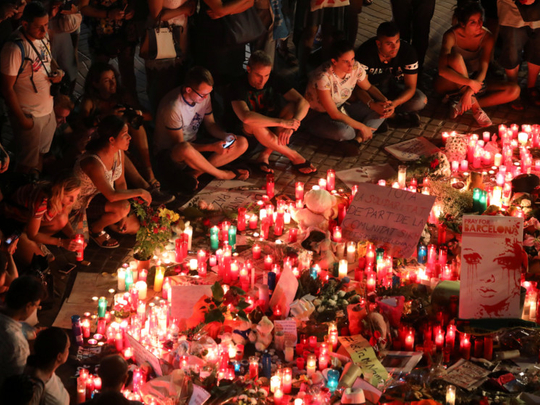
It was painful, conspicuous and easy: The sort of target terrorists are always looking for. Las Ramblas of Barcelona, Spain, where two men crashed a van on Thursday into unsuspecting bystanders, killing at least 13 people and wounding more than 100, is a wide, unprotected, mile-long pedestrian artery. It stretches from the busy urban centre to the old seaport.
At one end, the Fountain of Canaletas is where Barcelona football fans celebrate their triumphs. At the opposite end, a statue of Christopher Columbus points a finger towards the Mediterranean, a symbol of Barcelona’s cosmopolitan vocation. Every year, tens of millions of people visit the city, and virtually all of them will, at some point, take a stroll along Las Ramblas, promenading amid the kiosks, the flower sellers and the sidewalk cafes, enjoying the scent of coffee, lilies and roses.
Hours after the vehicular assault in Las Ramblas, a car drove into a crowd in Cambrils, a seaside resort town about 70 miles (113km) away, killing one woman and injuring scores more civilians. Five suspects were shot dead at the scene by the police.
Thursday’s attacks will have sent shudders down the spine of the millions who’ve visited Barcelona. That’s the point of this sort of postcard city terrorism: To kill people we can all relate to, in places that evoke peaceful memories, in order to turn the safe and pleasant landscape of everyday life into one of vulnerability and fear. Like the Promenade des Anglais in Nice, attacked in July 2016. Like the Berlin Christmas market, attacked in December the same year. Like Westminster Bridge in London, attacked last March. Like Drottninggatan street in Stockholm, targeted in April.
It is no coincidence that all those places happen to be pedestrian streets. There’s something particularly civilised about them. They’re urban spaces that have been reclaimed for the people in the name of leisure. They humanise cities, slow their pace, create oases. Apart from the obvious fact that they’re readily accessible to the latest terror weapon of choice — the truck, van or car — this seems to be another reason why these places attract this sort of hatred: For a city dweller, they embody a certain idea of happiness.
In Las Ramblas, the terrorists’ van finally crashed to a halt right in front of the beautiful Teatre del Liceu — an unintended symbolism, for this opera hall, the emblem of the city’s bourgeois charm and of its devotion to the arts, was also the site of another terror attack of a bygone era that is now part of the city’s legend: The Liceu Bombing of 1893, when an anarchist militant threw grenades during a performance of Rossini’s William Tellem. Twenty people died in that distant precedent of mindless, nihilist violence.
The persistent fantasy
For most Spaniards, there are more immediate memories of terrorism. The 2004 Madrid train bombings, carried out by an Al Qaida cell, remain a national trauma. Then, a series of bomb explosions on several trains killed 192 people. Ever since, there have been concerns that something like that could happen again. But that fear remained unspoken. And even when plots were uncovered and suspects detained, the fantasy persisted that the country, somehow, had had its unfair share of sorrow. Tragically, Barcelona proves it doesn’t work like that.
The 2004 Madrid train bombings took place in the context of a country divided between those who had opposed the 2003 military intervention in Iraq and those who justified it. Thursday’s attacks also come at a difficult time. The city of Barcelona is going through an identity crisis. Since it hosted the 1992 Olympic Games, it has striven to become a world tourist destination. Now that it has succeeded beyond all expectations, many complain — perhaps rightly, but not always peacefully — that mass tourism is killing the city’s soul.
At the same time, Barcelona is the capital of Catalonia, where another drama is playing out between those who demand independence from Spain and those who oppose it. Thursday’s attack has momentarily put all that to rest. With the blood of tourists shed in the streets of Barcelona, the Spanish and Catalan police forces are working together to tackle the common threat.
Perhaps inevitably, the bitter differences will re-emerge as the shock recedes. And yet, between now and then, the horror has opened a window through which we are able to catch a glimpse of our common humanity, of how frail it is, of how thin is the line that divides civility from barbarism.
Cityscapes are so embedded in the life of our nations that any major event that happens in them has inadvertent historical resonance and additional meaning. In Stockholm, the terrorist started his car in the street where Olof Palme, the former Swedish prime minister who embodied an ideal of social cohesion, was assassinated many years before.
Denunciation of totalitarianism
In London, the attacker knifed his way right up to the gates of the parliament, the visible representation of democracy’s long history. And it was in Las Ramblas of Barcelona, standing guard on a rooftop as a volunteer during the Spanish Civil War, that the British writer George Orwell was struck by a realisation that would ultimately lead him to write 1984, his enduring denunciation of totalitarianism and the politics of fear.
On Thursday, the terrorists began killing people precisely on the spot of Orwell’s epiphany. By the time the vehicle had ran its course, it had left a half-mile trail of pain. Already, on Friday, that scar was covered with a tribute of flowers. It occurred to me that many of them may have come from the same kiosks hit by the van.
“If you can feel that staying human is worth while,” wrote Orwell, “even when it can’t have any result whatever, you’ve beaten them.”
— New York Times News Service
Miguel-Anxo Murado is a Spanish author and journalist.












